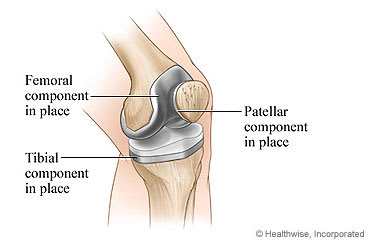Your Recovery

After knee replacement surgery, you will be taken to the recovery room. In a few hours, you may go to a hospital room. You may see a metal triangle called a trapeze over your bed. You can use this to help move yourself around in bed. You will be very tired and will want to rest. Your nurse may also help turn you as you rest.
You will be getting fluids into your vein through an I.V. tube. You may also have a tube called a drain near the cut (incision) in your knee.
You may not feel hungry. You may feel sick to your stomach or constipated for a couple of days. This is common. Your nurse may give you stool softeners or laxatives to help with constipation.
You may have stockings that put pressure on your legs to prevent blood clots. Your nurse will also give you medicine and exercise instructions to help prevent clots.
Most people get out of bed with help on the day of surgery. Your doctor will let you know if you will stay in the hospital or if you can go home the day of surgery.
This care sheet gives you a general idea about how your recovery will begin in the hospital. Each person has a different experience and recovers at a different pace.
How can you care for yourself?
Pain and pain medicine
- You will receive medicine to help control pain. Some pain medicines are given through an I.V. Others are taken by mouth.
- Take it as needed, and remember that it is easier to prevent pain before it starts than to stop it after it has started.
- If you are still in pain after you take your medicine, tell your nurse. You may need new medicine or to get the medicine in a different form.
Other medicines
- Your doctor will tell you if and when you can restart your medicines. You will also get instructions about taking any new medicines.
- If you stopped taking aspirin or some other blood thinner, your doctor will tell you when to start taking it again.
- Your doctor will probably give you blood thinners to prevent blood clots in your leg. You take this medicine during your hospital stay and when you go home.
Rehabilitation
- Your rehabilitation (rehab) will probably begin the day of your surgery. Your physical therapist will get you started. It may be painful to exercise at first, but your nurse will give you pain medicine if you need it.
- Your physical therapist will help you walk, go up and down stairs, and get in and out of bed and chairs. The therapist will help improve the movement (range of motion) and strength in your knee. You will learn positions and motions that will be safe and help you be comfortable.
- How quickly you regain strength and motion and do things on your own depends on how well you follow your physical therapy. Your physical therapist will teach you the exercises, but you must do them yourself.
- You will learn how to bathe, dress, and do daily activities. You may need tools to help with everyday activities. Tools include shower stools, shoehorns, and long-handled sponges.
Diet
- You can eat your normal diet.
- If your bowel movements are not regular right after surgery, try to avoid constipation and straining. Drink plenty of water. Your doctor may suggest fiber, a stool softener, or a mild laxative.
Incision care
- You will have a bandage over your incision. Your nurse will care for this.
Other instructions
- Your nurse or respiratory therapist will have you do breathing and coughing exercises to prevent problems such as pneumonia. Breathe in deeply through your nose, and slowly breathe out through your mouth. Do this 3 times, and then cough 2 times.
- You may have a device (incentive spirometer) that you suck air through to help keep your lungs healthy. Use this as your nurse or therapist tells you to.
When should you call for help?
- You have severe trouble breathing.
- You have a cough, shortness of breath, or chest pain.
- You are sick to your stomach or cannot keep fluids down.
- You have symptoms of a blood clot in your leg (called a deep vein thrombosis), such as:
- Pain in the calf, back of the knee, thigh, or groin.
- Swelling in the leg or groin.
- A color change on the leg or groin. The skin may be reddish or purplish.
- You are in pain or your pain does not get better after you take pain medicine.
- Bright red blood has soaked through the bandage over your incision.
- You have signs of infection, such as:
- Increased pain, swelling, warmth, or redness.
- Red streaks leading from the incision.
- Pus draining from the incision.
- A fever.
Where can you learn more?
Go to http://www.healthwise.net/patientEd
Enter R819 in the search box to learn more about "Total Knee Replacement: What to Expect at the Hospital".
Current as of: July 24, 2025
Author: Ignite Healthwise, LLC Staff
Clinical Review Board
All Ignite Healthwise, LLC education is reviewed by a team that includes physicians, nurses, advanced practitioners, registered dieticians, and other healthcare professionals.

